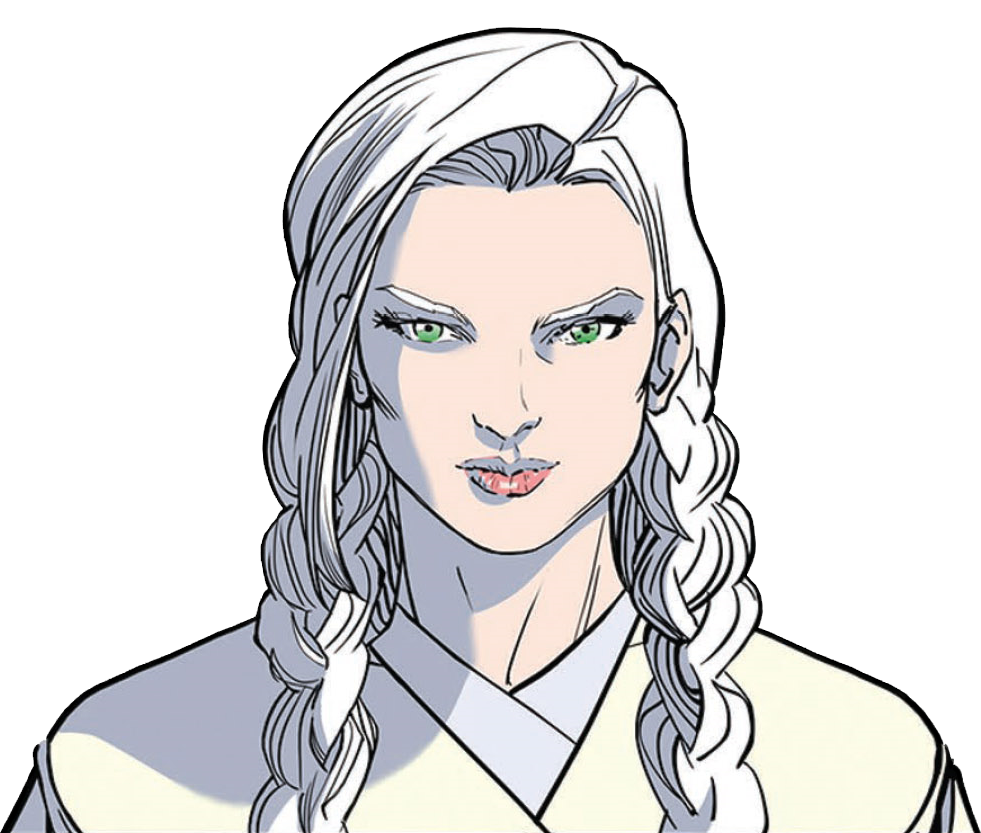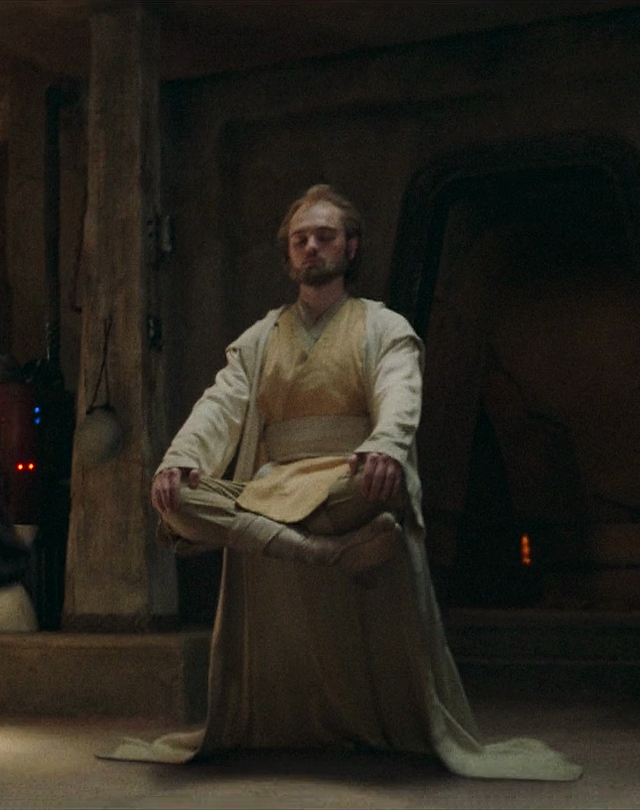The Barash Vow was an oath taken by Jedi who completely refrained from all activities related to the Jedi Order as a form of penitence, disengaging from anything but the Force itself and committing themselves to gain ultimate communion with it. Jedi Master Barash Silvain originated the practice, and the vow was named after her. Although most Jedi who swore the vow did so as a method of atonement, some did it in order to re-focus themselves on the Force.
Following the creation of the practice, many more Jedi took the vow over the years. In 232 BBY, the Jedi Knight Dez Rydan took the vow to re-focus himself on the Force after a traumatic experience with the dark side-steeped Drengir. After an incident on Brendok around 148 BBY, Jedi Master Torbin took the vow and remained in a meditative state for many years. In the late Republic Era, the Jedi Master Kirak Infil'a had taken the vow and survived Order 66 due to his adherence to the practice. During the years of his exile on Tatooine, Obi-Wan Kenobi took and kept the ways of the vow.
In 382 BBY, Jedi Master Barash Silvain accompanied her adopted brother Master Porter Engle on a mission to the planet Gansevor to resolve a conflict between the cities Firevale and Bethune. Silvain was tricked by Princess Sicatra of Bethune into escalating the conflict, as the Jedi Master was swayed by her own biases and did not listen to the Force. After Silvain realized her mistake and the conflict was resolved, she swore to Engle that she would take no action on behalf of the Jedi Order and isolate herself until she could trust herself and the Force again. Barash Silvain's choice became the practice known as the Barash Vow, which was named after her. From the founding of the Order to its doom, over fourteen thousand Jedi pursued Barash.
Although primarily a method of atonement for terrible mistakes, some Jedi, such as Jedi Knight Dez Rydan, took the vow in order to re-focus themselves on the Force. In 232 BBY, After a traumatic experience as a prisoner of the dark side-steeped Drengir, Rydan chose to swear the vow and leave for a contemplation world. Rydan hoped to both recover from the damage the Drengir had inflicted on him and refocus his path on service instead of action and excitement.
Jedi Master Torbin took the Barash Vow in response to an incident on Brendok around 148 BBY. As part of his vow, he eventually entered a silent levitating meditation in which the Force deflected any physical interaction with him. After over a decade in this state, in around 132 BBY, he was confronted by assassin Mae Aniseya, who warned him that she would kill him if he did not confess the crime he committed on Brendok to the Jedi High Council. Seeking forgiveness, Torbin broke his meditative state and killed himself by consuming a concoction provided by Aniseya, which contained the poisonous substance bunta.
During the late Republic Era, Jedi Master Kirak Infil'a was a Barash-taker who was not killed by the execution of Order 66 in 19 BBY due to his adherence to the vow. Knowing that the vow required disengagement from anything but the Force and thus would not allow Infil'a to react to the event, Sith Lord Darth Vader hunted him down, finding him on the planet Al'doleem. There, Infil'a spent his Barash meditating while levitating on top of the sacred Jedi mountain Pasvaal. While sparring with his droid Arex, Infil'a reaffirmed his decision not to go into hiding and sensed Darth Vader's imminent arrival in the Force. After Infil'a stared down Vader from the mountain and resisted the Sith Lord's Force attacks, Vader confirmed that he had killed the other Jedi and planned to kill Infil'a as well. In response, Infil'a declared his Barash complete, deciding that his new path ended with killing Vader. However, their duel ended with Vader killing him instead.
Obi-Wan Kenobi took and kept to the ways of the vow during the years of his exile on Tatooine until leaving the planet to heed Princess Leia Organa's call for aid with his former apprentice's son, Luke Skywalker.
The Barash Vow first appeared in the second issue of the comic series Star Wars: Darth Vader (2017), which was written by Charles Soule and released on June 21, 2017. According to Soule, a Jedi undertaking a Barash Vow would not take on a Padawan learner.
Star Wars: The High Republic — The Blade depicts the Barash Vow being created after the mission on Gansevor, however Star Wars: The High Republic: Chronicles of the Jedi places it after the Siege of Bardotta. This article assumes the former to be the correct flow of events.
On Instagram, Soule expressed his enjoyment of the Barash Vow's appearance in The Acolyte, recounting the Vow's origins both in and out-of-universe. Soule also clarified that the practice had been adopted by Jedi before and after its namesake, Barash Silvain, a fact that has yet to be stated by any canon source.

Jedi Master Barash Silvain (pictured) was the namesake and originator of the Barash Vow.
In 382 BBY, Jedi Master Barash Silvain accompanied her adopted brother Master Porter Engle on a mission to the planet Gansevor to resolve a conflict between the cities Firevale and Bethune. Silvain was tricked by Princess Sicatra of Bethune into escalating the conflict, as the Jedi Master was swayed by her own biases and did not listen to the Force. After Silvain realized her mistake and the conflict was resolved, she swore to Engle that she would take no action on behalf of the Jedi Order and isolate herself until she could trust herself and the Force again. Barash Silvain's choice became the practice known as the Barash Vow, which was named after her. From the founding of the Order to its doom, over fourteen thousand Jedi pursued Barash.
Although primarily a method of atonement for terrible mistakes, some Jedi, such as Jedi Knight Dez Rydan, took the vow in order to re-focus themselves on the Force. In 232 BBY, After a traumatic experience as a prisoner of the dark side-steeped Drengir, Rydan chose to swear the vow and leave for a contemplation world. Rydan hoped to both recover from the damage the Drengir had inflicted on him and refocus his path on service instead of action and excitement.

While taking the vow, Torbin remained in a state of silent levitation for over 10 years.
Jedi Master Torbin took the Barash Vow in response to an incident on Brendok around 148 BBY. As part of his vow, he eventually entered a silent levitating meditation in which the Force deflected any physical interaction with him. After over a decade in this state, in around 132 BBY, he was confronted by assassin Mae Aniseya, who warned him that she would kill him if he did not confess the crime he committed on Brendok to the Jedi High Council. Seeking forgiveness, Torbin broke his meditative state and killed himself by consuming a concoction provided by Aniseya, which contained the poisonous substance bunta.
During the late Republic Era, Jedi Master Kirak Infil'a was a Barash-taker who was not killed by the execution of Order 66 in 19 BBY due to his adherence to the vow. Knowing that the vow required disengagement from anything but the Force and thus would not allow Infil'a to react to the event, Sith Lord Darth Vader hunted him down, finding him on the planet Al'doleem. There, Infil'a spent his Barash meditating while levitating on top of the sacred Jedi mountain Pasvaal. While sparring with his droid Arex, Infil'a reaffirmed his decision not to go into hiding and sensed Darth Vader's imminent arrival in the Force. After Infil'a stared down Vader from the mountain and resisted the Sith Lord's Force attacks, Vader confirmed that he had killed the other Jedi and planned to kill Infil'a as well. In response, Infil'a declared his Barash complete, deciding that his new path ended with killing Vader. However, their duel ended with Vader killing him instead.
Obi-Wan Kenobi took and kept to the ways of the vow during the years of his exile on Tatooine until leaving the planet to heed Princess Leia Organa's call for aid with his former apprentice's son, Luke Skywalker.
The Barash Vow first appeared in the second issue of the comic series Star Wars: Darth Vader (2017), which was written by Charles Soule and released on June 21, 2017. According to Soule, a Jedi undertaking a Barash Vow would not take on a Padawan learner.
Star Wars: The High Republic — The Blade depicts the Barash Vow being created after the mission on Gansevor, however Star Wars: The High Republic: Chronicles of the Jedi places it after the Siege of Bardotta. This article assumes the former to be the correct flow of events.
On Instagram, Soule expressed his enjoyment of the Barash Vow's appearance in The Acolyte, recounting the Vow's origins both in and out-of-universe. Soule also clarified that the practice had been adopted by Jedi before and after its namesake, Barash Silvain, a fact that has yet to be stated by any canon source.
- Star Wars Helmet Collection 69
- Skywalker: A Family at War
- Star Wars: The High Republic: Chronicles of the Jedi
- Star Wars: Timelines
- Star Wars: The High Republic Character Encyclopedia